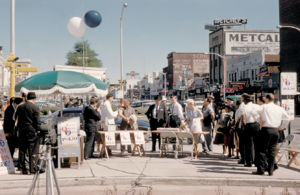Two polio vaccines are used throughout the world to combat poliomyelitis (or polio). The first was developed by Jonas Salk and first tested in 1952. Announced to the world by Salk on April 12, 1955, it consists of an injected dose of inactivated (dead) poliovirus. An oral vaccine was developed by Albert Sabin using attenuated poliovirus. Human trials of Sabin's vaccine began in 1957 and it was licensed in 1962.[1] Because there is no long term carrier state for poliovirus in immunocompetent individuals, polioviruses have no non-primate reservoir in nature, and survival of the virus in the environment for an extended period of time appears to be remote. Therefore, interruption of person to person transmission of the virus by vaccination is the critical step in global polio eradication.[2] The two vaccines have eliminated polio from most countries in the world,[3][4] and reduced the worldwide incidence from an estimated 350,000 cases in 1988 to 1,652 cases in 2007.[5][6][7]
Contents
- 1 Development
- 2 Inactivated vaccine
- 3 Oral vaccine
- 4 Iatrogenic (vaccine-induced) polio
- 5 Contamination concerns
- 6 References
- 7 External links
Development
In the generic sense, vaccination works by priming the immune system with an 'immunogen'. Stimulating immune response, via use of an infectious agent, is known as immunization. The development of immunity to polio efficiently blocks person-to-person transmission of wild poliovirus, thereby protecting both individual vaccine recipients and the wider community.[2]
In 1936, Maurice Brodie, a research assistant at New York University, attempted to produce a formaldehyde-killed polio vaccine from ground-up monkey spinal cords. His initial attempts were hampered by the difficulty of obtaining enough virus. Brodie first tested the vaccine on himself and several of his assistants. He then gave the vaccine to three thousand children, many of whom developed allergic reactions, but none developed immunity to polio.[8] Philadelphia pathologist John Kolmer also claimed to have developed a vaccine that same year, but it too produced no immunity and was blamed for causing a number of cases, some of them fatal.[9]

Mass polio vaccination in Columbus, Georgia during the early days of the National Polio Immunization Program.
A breakthrough came in 1948 when a research group headed by John Enders at the Children's Hospital Boston successfully cultivated the poliovirus in human tissue in the laboratory.[10] This development greatly facilitated vaccine research and ultimately allowed for the development of vaccines against polio. Enders and his colleagues, Thomas H. Weller and Frederick C. Robbins, were recognized in 1954 for their labors with a Nobel Prize in Physiology or Medicine.[11] Other important advances that led to the development of polio vaccines were: the identification of three poliovirus serotypes (Poliovirus type 1 — PV1, or Mahoney; PV2, Lansing; and PV3, Leon); the finding that prior to paralysis, the virus must be present in the blood; and the demonstration that administration of antibodies in the form of gamma-globulin protects against paralytic polio.[6][12]
In 1952 and 1953, the U.S. experienced an outbreak of 58,000 and 35,000 polio cases, respectively, up from a typical number of some 20,000 a year. Amid this U.S. polio epidemic, millions of dollars were invested in finding and marketing a polio vaccine by commercial interests, including Lederle Laboratories in New York under the direction of H. R. Cox. Also working at Lederle was Polish-born virologist and immunologist Hilary Koprowski, who claims to have created the first successful polio vaccine, in 1950. His vaccine, however, being a live attenuated virus taken orally, was still in the research stage and would not be ready for use until five years after Jonas Salk's polio vaccine (a dead injectable vaccine) had reached the market. Koprowski's attenuated vaccine was prepared by successive passages through the brains of Swiss albino mice. By the seventh passage, the vaccine strains could no longer infect nervous tissue or cause paralysis. After one to three further passages on rats, the vaccine was deemed safe for human use.[13][14] On February 27, 1950, Koprowski's live, attenuated vaccine was tested for the first time on an eight year old boy from Letchworth Village, New York. The boy suffered no side effects and Koprowski enlarged his experiment to include 19 other children.[13][15]
The development of two polio vaccines led to the first modern mass inoculations. The last cases of paralytic poliomyelitis caused by endemic transmission of wild virus in the United States occurred in 1979, with an outbreak among the Amish in several Midwest states.[16] A global effort to eradicate polio, led by the World Health Organization, UNICEF, and The Rotary Foundation, began in 1988 and has relied largely on the oral polio vaccine developed by Albert Sabin.[17] The disease was entirely eradicated in the Americas by 1994.[18] Polio was officially eradicated in 36 Western Pacific countries, including China and Australia in 2000.[19][20] Europe was declared polio-free in 2002.[21] As of 2008, polio remains endemic in only four countries: Nigeria, India, Pakistan, and Afghanistan.[5] Although poliovirus transmission has been interrupted in much of the world, transmission of wild poliovirus does continue and creates an ongoing risk for the importation of wild poliovirus into previously polio-free regions. If importations of poliovirus occurs, outbreaks of poliomyelitis may develop, especially in areas with low vaccination coverage and poor sanitation. As a result, high levels of vaccination coverage must be maintained.[18]
(Source from en.Wikipedia.org/wiki/Polio_vaccine)
Related info see also:



No comments:
Post a Comment